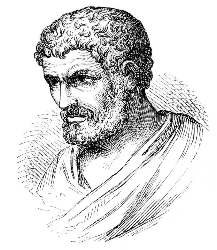  Euclid was an ancient Greek mathematician. Considered the 'father of geometry', he is best known for his work entitled 'Elements', which established the foundations of geometry that largely dominated the field until the early 19th century.
Euclid was an ancient Greek mathematician. Considered the 'father of geometry', he is best known for his work entitled 'Elements', which established the foundations of geometry that largely dominated the field until the early 19th century.Little is known of Euclid's life except that he taught at Alexandria in Egypt, some time between 323 and 285 BC. His major work 'Elements' is not just about geometry, although Books I through IV cover elementary plane geometry. Euclid knew that mathematics needed a thorough foundation in geometry, so that's where he started. But he wrote about a lot more! Euclid began with absolutely basic tenets that were fundamental to all the mathematics to come. He started out with some definitions, like: "a point is that which has no part" and "a line is a length without breadth"'. Next came the following:
Book I then proves elementary theorems about triangles and parallelograms, and ends with the Pythagorean theorem. The subject of Euclid's second book has been called geometric algebra because it states algebraic identities as theorems about equivalent geometric figures. Euclid also generalized the Pythagorean theorem to arbitrary triangles, essentially descibing the cosine law. Book III deals with properties of circles and Book IV with the construction of regular polygons, in particular the pentagon. Books VII–IX contain elements of number theory, where Euclid developed various properties of the positive integers, such as an algorithm for finding the greatest common divisor of two or more numbers; and an exploration of geometric sequences. Books XI–XIII examine three-dimensional figures, the intersections of planes, lines, and parallelepipeds (solids with parallel parallelograms as opposite faces). Book XIII ends with the construction of the five regular Platonic solids. Almost from the time of its writing, the Elements had a major influence on human affairs. It was the primary source of geometric reasoning, theorems, and methods at least until the 19th century. It is sometimes said that, other than the Bible, the Elements is the most translated, published, and studied of all the books produced in the Western world. Euclid set a standard for deductive reasoning and geometric instruction that persisted, practically unchanged, for more than 2,000 years. |